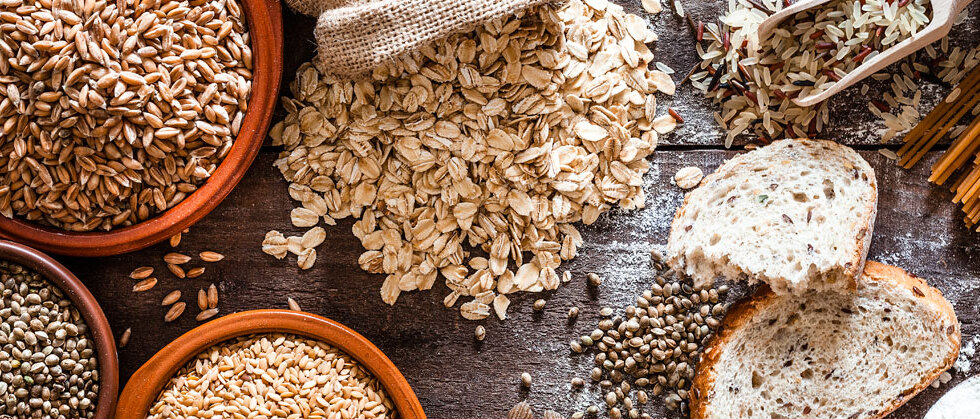Insoluble fiber is essential for maintaining a healthy digestive system, playing a key role in promoting regular bowel movements and reducing the risk of various digestive issues such as diverticular diseases, hemorrhoids, and constipation (1). Research also indicates its role in weight management, blood sugar stabilization, and potentially in reducing the risk of colon cancer (2).
In the realm of dietary fibers, insoluble and soluble fibers each play unique and vital roles in our health.
Soluble fiber, found in an array of foods like fruits, vegetables, and legumes, is composed mainly of pectic substances and hydrocolloids. Discover more about these foods on our comprehensive Soluble Fiber Foods list.
Insoluble fiber, on the other hand, predominantly made up of cellulose and hemicellulose, is primarily found in whole grains such as corn, wheat, and oats (1). Additionally, this type of fiber is found in various fruits, nuts, and seeds, offering a wide range of options for different dietary preferences (3).

Table of Contents
Insoluble Fiber Foods
Below is a diverse list of diverse foods rich in insoluble fiber, to ensure your daily insoluble fiber intake is on point:
1. Wheat Bran
Wheat Bran, the protective outer layer of the wheat kernel removed during milling, is an excellent source of dietary fiber, predominantly insoluble fiber. It is particularly rich in minerals like magnesium, iron, and zinc. Incorporating wheat bran into your diet, such as in morning cereals or baked goods, can significantly boost your fiber intake.
Insoluble Fiber Content: 100 grams of Wheat Bran contains approximately 36.3 grams of insoluble fiber. The Hemicellulose and Cellulose content of Wheat Bran constitute 44% and 32.2% of its total dietary fiber, respectively.
2. Linseed (Flaxseed)
Flaxseeds, or linseeds, are small but mighty seeds known for their high content of both soluble and insoluble fibers, along with omega-3 fatty acids, beneficial for heart health. They are versatile in use and can be added to smoothies, cereals, and baked goods to enhance nutritional value.
Insoluble Fiber Content: 100 grams of Flaxseeds contains about 27.2 grams of insoluble fiber.
3. Cocoa Powder
Cocoa powder, obtained from cocoa beans, is more than just a baking ingredient or a hot chocolate enhancer. It’s a good source of fiber, particularly insoluble fiber, and antioxidants. Opting for unsweetened varieties helps avoid excess sugar intake.
Insoluble Fiber Content: 100 grams of Cocoa Powder contains around 22.8 grams of insoluble fiber.
4. Oat Bran
Oat Bran, the nutrient-packed outer layer of the oat grain, is rich in both fiber and other essential nutrients. It’s a versatile addition to meals and snacks, enhancing dishes like porridge, smoothies, and baked goods with its high fiber content.
Insoluble Fiber Content: 100 grams of Oat Bran contains approximately 16.7 grams of insoluble fiber.
5. Dried Carrots
Dried carrots, a less common form of carrots, retain much of the nutrient content of their fresh counterparts and are a good source of fiber, especially insoluble fiber. They can be rehydrated for soups and stews or eaten as is in trail mixes and snacks.
Insoluble Fiber Content: 100 grams of Dried Carrots contains about 13.8 grams of insoluble fiber.
6. Brown/White Beans
Beans, both brown and white varieties, are nutritious and versatile, high in protein and fiber. Their insoluble fiber content makes them excellent for adding to salads, soups, stews, and dips like hummus.
Insoluble Fiber Content: 100 grams of Brown/White Beans contain approximately 13.5 grams of insoluble fiber.
7. Coconut Flakes
Coconut flakes, derived from the inner flesh of coconuts, offer a delightful taste and are rich in fiber, particularly insoluble fiber. They are a great addition to various dishes, providing a tropical flavor and boosting fiber content.
Insoluble Fiber Content: 100 grams of Coconut Flakes contain around 13.3 grams of insoluble fiber.
8. Rye Crispbread
Rye Crispbread, a flatbread made from rye flour, is a crunchy, fiber-rich alternative to regular bread. It complements a range of toppings and is a good option for those aiming to increase their fiber intake.
Insoluble Fiber Content: 100 grams of Rye Crispbread contains about 12.8 grams of insoluble fiber.
9. Wheat Germ
Wheat germ, the nutrient-rich core of the wheat kernel, is packed with both soluble and insoluble fiber. It’s an excellent additive for yogurt, smoothies, salads, and baked goods, offering a nutritional boost.
Insoluble Fiber Content: 100 grams of Wheat Germ contains approximately 12.7 grams of insoluble fiber.
10. Bran Flakes
Bran flakes, a common wheat bran-based breakfast cereal, are a convenient way to start your day with a fiber-rich meal. Keep an eye on the labels to avoid varieties with added sugars.
Insoluble Fiber Content: 100 grams of Bran Flakes contain about 11.6 grams of insoluble fiber.
11. Green Peas
Green peas are a nutritious addition to soups, salads, and side dishes, offering a good balance of soluble and insoluble fiber. They are also rich in vitamins A, C, K, and several B vitamins.
Insoluble Fiber Content: 100 grams of Green Peas provide approximately 5.5 grams of insoluble fiber.
12. Avocado
Avocados are known for their healthy fats and also provide a substantial amount of dietary fiber, especially insoluble fiber. They can be enjoyed in various forms, like in salads, on toast, or in smoothies.
Insoluble Fiber Content: An average-sized Avocado contains about 9 grams of insoluble fiber.
To safely increase fiber intake, it’s recommended to do so gradually and to increase water consumption to aid in digestion (4). Contrary to common belief, not all types of fiber cause bloating and can be found in various food groups (5). Consultation with a nutritionist or dietitian is advisable for tailored dietary advice.
Note: When focusing on insoluble fiber, it’s also important to consider the overall nutritional profile of these foods, including their calorie, sugar, and fat content.
For individuals with specific dietary needs, fiber supplements like methylcellulose, which is predominantly insoluble, and psyllium, containing both soluble and insoluble fiber, are options. Increasing fiber intake should be paired with sufficient hydration.
Among commercially extracted fiber products, oat fiber is notable for its high insoluble fiber content (73.6%) (6)
Recommended Daily Insoluble Fiber Intake
While specific guidelines for insoluble fiber alone are not established, the recommended daily intake for total dietary fiber is approximately 38 grams for men and 25 grams for women under 50 years old (5). For adults over 50, a reduced intake of around 20-25 grams is suggested to minimize potential digestive issues (4). These recommendations are based on guidelines from authoritative health organizations.
It’s important to note that individual dietary requirements vary. Consulting with a healthcare professional is recommended when considering significant dietary changes.
